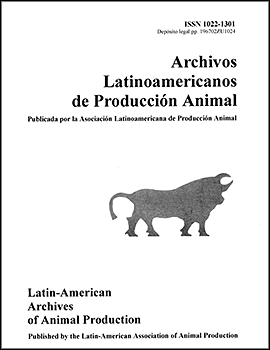
|
Archivos Latinoamericanos de Produccion Animal
Asociacion Latinoamericana de Produccion Animal
ISSN: 1022-1301
EISSN: 1022-1301
Vol. 16, No. 4, 2008, pp. 210-215
|
 Bioline Code: la08029
Bioline Code: la08029
Full paper language: English
Document type: Research Article
Document available free of charge
|
|
|
Archivos Latinoamericanos de Produccion Animal, Vol. 16, No. 4, 2008, pp. 210-215
| en |
Percentil variation and feeding frequeency supplied in the final development of silver calfish ( Rhandia quelen  ) in the phase ) in the phase
Graeff, Á. & Pruner, E.N.
Abstract
The experiment was led during a 65-day period, in the Estação de Piscicultura/EPAGRI, belonging to Estação Experimental of Caçador/SC. Forty bowls with the capacity of 40 liters were used, with individual supply and flow, each bowl was considered as an experimental unit. The experimental desing was random in a factorial scheme where the factor A was the percentage of daily feed (1, 2, 3, 4, 5%) and the factor B is the daily frequency of feed (once or twice a day) with 4 repetitions. The variables weight gain, length gain, survival and feed conversion ratio were submitted to of variance analysis. The ration used was bought in the local store with 28%BP and 2.800Kcal of EM/kg of ration inside the criteria, for the species. Six silver catfish (Rhamdia quelen) fingerlings were stored per bowl with medium weight of 0,08 ± 0,01g and medium length of 1,5 ± 0,1cm, 23 days old. The water temperature evaluations were dore daily, always at 09:00h and at 15:00h. At these moments, the fishes were given the daily ration. The fish biometry was done at the beginning of the experiment, 30 days later and at the end of the experiment, 65 days after the beginning, using 100% of the stored fishes, when the measures of total length, individual weight, survival and feed conversion rate were performed. For the raising of silver catfish (Rhamdia quelen) fingerlings in the breeding phase the frequency of ideal feed was once a day at 2 to 5% of its weight per day.
Keywords
food, silver catfish, breeding, Rhamdia quelen
|
| |
| es |
Variação percentual e freqüencia de alimento fornecido no desenvolvimento final de jundiás ( Rhandia quelen  ) na fase de recria ) na fase de recria
Graeff, Á. & Pruner, E.N.
Resumen
Foram utilizados 40 aquários de 40 litros de capacidade, com abastecimento e escoamento individualizado, sendo que cada aquário foi considerado uma unidade experimental. O delineamento experimental foi inteiramente ao acaso em um esquema fatorial onde o fator A é o percentual de alimentação diária (1,2, 3, 4, 5%) e o fator B é a freqüência diária de oferta da alimentação (1 ou 2 vezes ao dia) com 4 repetições. As variáveis ganho de peso, comprimento, sobrevivência e conversão alimentar aparente foram submetidasà análise da variância. A ração utilizada foi comprada no comercio local com 28%PB e 2.800 Kcal de EM/kg de ração dentro dos critérios, para a espécie. Foram estocados 6 alevinos de carpa comum (Cyprinus carpio L.) por aquário com peso médio de 0,08 ± 0,01g e comprimento médio de 1,5 ± 0,1cm, com 23 dias de idade. As avaliações da temperatura da água foram feitas diariamente, sempre às 09:00 horas e 15:00 horas. Neste momento, os peixes recebiam a ração diária. A biometria dos peixes foi realizada no inicio do experimento com 30 dias e no final do experimento com 65 dias, utilizando-se 100% dos peixes estocados, quando foram realizadas as medidas de comprimento total, peso individual, sobrevivência e conversão alimentar aparente. No cultivo de alevinos de jundiás (Rhamdia quelen) na fase de recria a freqüência de alimentação ideal é uma vez ao dia no percentual de 2 a 5% do seu peso por dia.
Palabras-clave
alimento, freqüência, jundiá, percentual, recria, Rhamdia quelen Percentile variation and frequency of food supplied in the final development of silver catfish (Rhandia quelen) in the phase of it recreates
|
| |
© Copyright 2008 Archivos Latinoamericanos de Produccion Animal.
Alternative site location: http://www.alpa.org.ve/ojs/index.php
|
|
